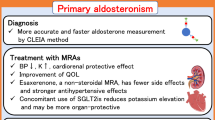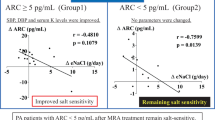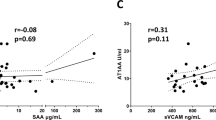Abstract
Mineralocorticoid secretion is predominantly controlled by the octapeptide angiotensin II, which exerts trophic actions on the adrenal glomerulosa and acute regulatory effects on aldosterone biosynthesis. The trophic actions include stimulation of angiotensin II receptors and enzymes of the aldosterone biosynthetic pathway1,2, with corresponding enhancement of the aldosterone secretory capacity of the adrenal gland. The positive regulatory action of angiotensin II on its adrenal receptors occurs with elevations of the circulating peptide concentration within the physiological range and probably contributes to the increased sensitivity of the adrenal during sodium deficiency3,4. In this action, angiotensin II differs from other hormones which decrease their target-cell receptors5–7. However, the increase in adrenal angiotensin II receptors following nephrectomy has been interpreted as evidence for a tonic down-regulating effect of angiotensin II on its adrenal receptors8. To clarify these conflicting views we evaluated the effects of nephrectomy on adrenal angiotensin II receptors in relation to blood angiotensin II and plasma electrolyte levels. We show here that hyperkalaemia contributes markedly to the post-nephrectomy increase in adrenal angiotensin II receptors, and that circulating angiotensin II levels persist for an unexpectedly long period after nephrectomy, presumably due to tissue generation of the octapeptide.
This is a preview of subscription content, access via your institution
Access options
Subscribe to this journal
Receive 51 print issues and online access
$199.00 per year
only $3.90 per issue
Buy this article
- Purchase on Springer Link
- Instant access to full article PDF
Prices may be subject to local taxes which are calculated during checkout
Similar content being viewed by others
References
Hauger, R.L., Aguilera, G. & Catt, K.J. Nature 271, 176–178 (1978).
Aguilera, G., Menard, R. & Catt, K. J. Endocrinology 107, 55–60 (1980).
Aguilera, G. & Catt, K. J. Proc. natn. Acad. Sci. U.S.A. 75, 4057–4061 (1978).
Aguilera, G., Schirar, A., Baukal, A. & Catt, K. J. Circulation Res. 46, Suppl. I, 118–127 (1980).
Mukherjee, C., Caron, M. G. & Lefkowitz, R. J. Proc. natn. Acad. Sci. U.S.A. 75, 1945–1949 (1975).
Kahn, R. C., Neville, D. M. & Roth, J. J. biol. Chem. 248, 244–250 (1973).
Hsueh, A. J. W., Dufau, M. L. & Catt, K. J. Proc. natn. Acad. Sci. U.S.A. 74, 592–595 (1977).
Pernollet, M. G., Devynck, M. A., Matthews, P. G. & Meyer, P. Eur. J. Pharmac. 43, 361–372 (1977).
Glossmann, H., Baukal, A. & Catt, K. J. J. biol Chem. 249, 825–834 (1974).
Menard, J. & Catt, K. J. Endocrinology 90, 422–430 (1972).
Cain, M. D., Coghlan, J. P. & Catt, K. J. Clinica chim. Acta 39, 21–34 (1972).
Douglas, J. & Catt, K. J. J. clin. Invest. 58, 834–843 (1976).
Faden, V.B. & Rodbard, D. EXPFIT: Exponential Data Processing, 73 (National Institutes of Health, Maryland, 1975).
Aguilera, G. et al. Endocrinology 104, 1279–1285 (1979).
Johnston, C. I., Mendelson, F. A. O., Hutchinson, J. S. & Morris, B. in Mechanisms of Hypertension (ed. Sambhi, M. P.) 238–252 (Excerpta Medica, Amsterdam, 1973).
Morris, B. & Johnston, C. I. Endocrinology 100, 1409–1416 (1977).
Leary, W. F. & Ledingham, J. G. Nature 227, 178–179 (1970).
Ganten, D., Hayduk, K., Brecht, H. M., Boucher, R. & Genest, J. Nature 226, 551–552 (1970).
Ryan, J. W. & Johnson, D. C. Biochim. biophys. Acta 191, 386–371 (1969).
Weinberger, M. H. et al. Circulation Res. 40, Suppl. I, 1–3 (1977).
DiSalvo, J. & Montefusco, C. B. Am. J. Physiol. 221, 1576–1579 (1971).
Yang, H. Y. T. & Neff, N. H. J. Neurochem. 19, 2423–2428 (1972).
Cushman, D. W. & Chueng, A. W. Biochim. biophys. Acta 250, 261–263 (1971).
Thurston, H., Swales, J. D., Bing, R. F., Hurst, E. C. & Marks, E. S. Hypertension 1, 643–649 (1979).
Thurston, H. & Swales, J. D. Clin. Sci. molec. Med. 52, 299–304 (1977).
Yu, R., Anderton, J., Skinner, S. L. & Best, J. E. Am. J. Med. 52, 707–711 (1972).
Deneheffe, J. et al. Circulation Res. 39, 183–190 (1976).
Author information
Authors and Affiliations
Rights and permissions
About this article
Cite this article
Aguilera, G., Schirar, A., Baukal, A. et al. Circulating angiotensin II and adrenal receptors after nephrectomy. Nature 289, 507–509 (1981). https://doi.org/10.1038/289507a0
Received:
Accepted:
Issue Date:
DOI: https://doi.org/10.1038/289507a0
This article is cited by
-
Angiotensin II plasma levels are linked to disease severity and predict fatal outcomes in H7N9-infected patients
Nature Communications (2014)
-
Effect of enalapril and quinapril on forearm vascular ACE in man
European Journal of Clinical Pharmacology (1997)
-
A new method to localize active renin in tissues by autoradiography: Application to dog kidney
Kidney International (1992)
Comments
By submitting a comment you agree to abide by our Terms and Community Guidelines. If you find something abusive or that does not comply with our terms or guidelines please flag it as inappropriate.



